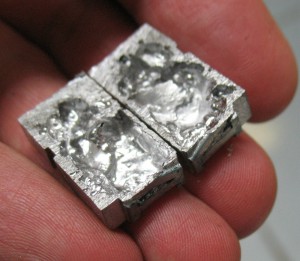My Monotype Composition Caster is a British-made one, with a serial number indicating fairly late manufacture (1960’s) so it should in theory be fitted will all the latest bells and whistles. But for some reason it is missing the pump modifications that are required for casting larger size display type. As a result when I try casting 36-point type I end up with hollow type whose face caves in after only a few impressions. Properly cast type of this size would have thicker solid walls and its core would be a froth of small bubbles.
There are three main requirements to casting sufficiently solid type:
- The molten type metal is injected into the casting mould by a single stroke of a piston pump, and this stroke must be able to pump enough metal to fill the type.
- The pump stroke must be fast enough that the mould fills before the metal in the injecting nozzle solidifies, stopping any further flow. Fast injection also replaces the large single air bubble with a froth of smaller bubbles, which is much stronger.
- The final pump pressure must be high enough to compress the bubbles to a small size. There is little chance for the air that starts in the mould cavity to escape, so the only way to reduce the bubble size is to compress the bubbles using several atmospheres of pressure.
My caster had the high-strength spring required for item (3), but did not have the extended-stroke pump required for (1) or the pump latch required for (2). As a result I am now working on installing these two items on my caster. This is proving to need a combination of scavenged parts and home-made parts.
The extended stroke piston consists of a piston rod modified to allow it to go further down during its stroke, along with a piston made shorter so it does not bottom out on the extended stroke. I have several of these shorter pistons collected as spares from various sources, but I find I have to make my own piston rod.
As for the pump latch mechanism, which holds back the pump piston then suddenly releases it, I finally have one to install, thanks to Rich Hopkins. This too needs some work though, as a couple of related parts are missing and the pump latch has some screws snapped off in their holes.
Finally, installing the pump latch, once I have it ready to go, requires disassembly of part of the pump operating head, so I decided that while I’m at it I would take the whole pump head apart and clean all the parts of the accumulations of hardened oil and gunk.
I will have more to say on each of these three phases in future posts.


Leave a Reply